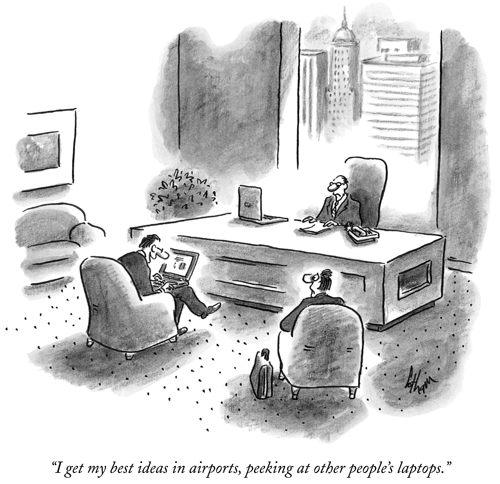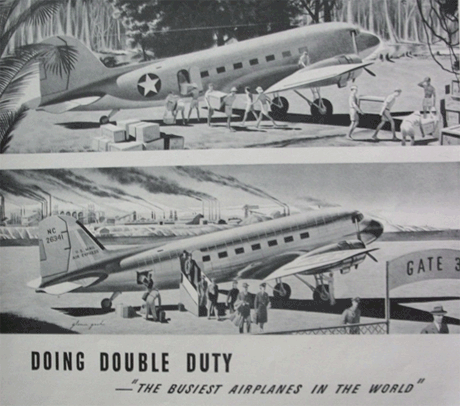
 ir
transport had to wait for decades before it could prove that the carriage
of heavy, bulky freight was a natural for the airplane. A few short
years later, America’s commercial airlines, hand in hand with
the Air Force, kept a blockaded Berlin alive with a duplicated mass
airlift of dazzling performance.
ir
transport had to wait for decades before it could prove that the carriage
of heavy, bulky freight was a natural for the airplane. A few short
years later, America’s commercial airlines, hand in hand with
the Air Force, kept a blockaded Berlin alive with a duplicated mass
airlift of dazzling performance.
In between these history-making events,
the world saw the unfolding of the Air Cargo Age. Airlines long-experienced
flying small shipments designated air express, were now seeking larger,
more weighty traffic. Facing them was a skeptical army influenced by
the airlines’ limited capacity and high rates.
Airline advertising displayed a notable
change in its themes, zeroing in on the economic value of speed, distance
of delivery and cargo safety.
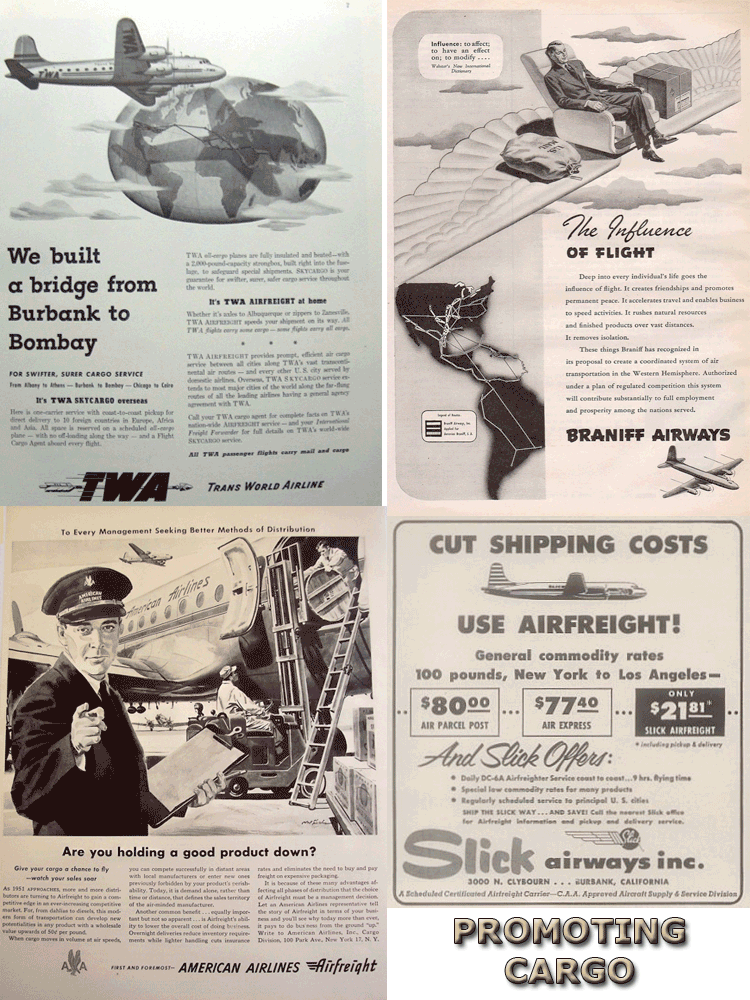 |
Typical was a Pan American Airways ad
which said, “Schedule your shipments as you would your personal
reservations.”
From United Airlines came this message:
“United, through connecting airlines and coordinated motor truck
lines, covers practically the entire country.”
Air France’s ad announced that
“One air waybill over one carrier all the way to destinations
in 51 countries on 5 continents.”
KLM’s ad promised, “Special
low rates for perishables.”
At TWA its ad people believed in a blunt
approach: “Every shipping file needs a TWA Air Freight tariff.”
Sabena’s ad claimed that its crews
were enhanced by “that extra margin of experience flying your
shipments.”
American Airlines’ ad, announced
a new all-cargo flight to Europe, whose “7-man crew is trained
to give utmost care to each shipment.”
In TACA’s ad it made a point of
stressing “full cooperation” by its skilled Latin American
cargo personnel.
The ads of REA Express took an educational
turn, providing air express case histories that underscored economic
trade-offs.
And so on, mirroring Spenser’s
“whirling wheel of change.”
At American Airlines the whirling wheel
produced an executive order converting six DC-4s to cargo configuration,
giving the carrier a freighter fleet of a dozen planes—a revolutionary
action.
Flying Tiger Line took another route
toward profitability, capturing a contract with the Air Transport
Command to fly 1.2 million miles a month from the West coast to Japan
and Hawaii. The deal made Flying Tiger the world’s largest contract
operator.
The DC-6, first of the postwar transports
made a successful bid for headlines when it set a Los Angeles-New
York speed record of 6:47:13 hours. The Douglas plane, which broke
the record previously held by a Constellation, was piloted by a United
Airlines crew.
North of the border CHN Cargo Aircraft
took the wraps off its bid for distinction with a rugged all-metal
freighter, The Loadmaster. The plane could be loaded at truck level
height at both sides.
Although operators of that new fangled
aircraft—the helicopter—were struggling to win a secure
place in the domestic airline industry, there was a small handful
of men whose visions extended to rotary wing freighters.
Quixotic in the Forties, to say the
least.
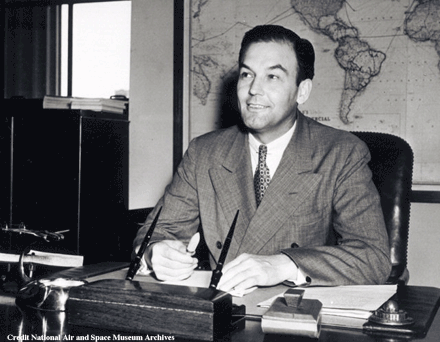 In
Washington, CAB Chairman L. Welch Pogue (left) cautioned against applying
to helicopter operations regulations governing airplanes.
In
Washington, CAB Chairman L. Welch Pogue (left) cautioned against applying
to helicopter operations regulations governing airplanes.
The Department of Commerce, an early
cheerleader for air transport progress, sounded a somewhat gloomy
note surveying the current air cargo scene, said that freight rates
were not moving adequately in a direction that would realize its full
potential. Also trotted forth as immediate needs were improved packaging,
better handling, upgraded ground handling and delivery and through
service for interline shipments.
Sciare facias (let it be known) is a
slogan that at least three periodicals have adopted. In this spirit
the Post Office Department reported that it has under consideration
a filing for reduced rates for airborne newspapers and news magazines
to foreign destinations.
Should the airline industry in the U.S.
be governed independently from other forms of transportation? Yes,
insisted, the CAB. No, contradicted the Port of New York Authority,
stating that foreign competitors have been strengthened by the U.S.
position.
The author, Bernard Estes, maintained
that air freight did not receive the promotion it merits. He held
that promotions should be stripped of the glamor of flying, and speak
with “the down-to-earth tongue” of the average person.
America, he concluded, “cannot afford to underpromote this type
of industry.”
A roughly similar line was taken by
analyst Langdon P. Marvin, Jr., who stated his belief that “if
the airlines which have been granted international certificates by
the Government devoted as much study, time and effort to cargo as
they have done during the past many years to passengers, they would
discover that there is perhaps twice as much business in the international
field as they now anticipate.
No one can accuse KLM Royal Dutch Airlines
of underpromoting its cargo business. As a point in fact, Holland’s
flag air carrier, was first in the world to put an all-cargo plane—a
converted Fokker F7—in service. This occurred 21 years earlier,
and KLM’s corporate eye has been on the shipper ever since.
Now, in early postwar New York, Albert Jansen headed freight in the
North American Division. Not unexpectedly, Jansen spoke enthusiastically
about Dutch flower exports and looked forward to seeing fresh airborne
blooms, especially tulips, in 70 U.S. cities through an interline
contract with United Airlines.
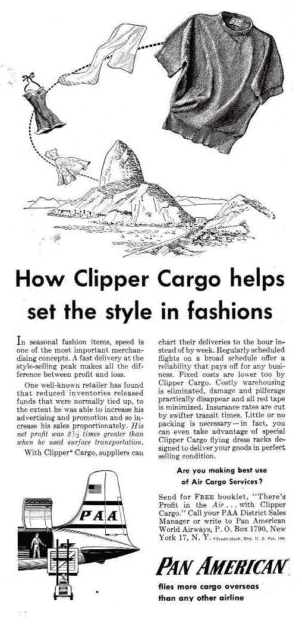 |
|
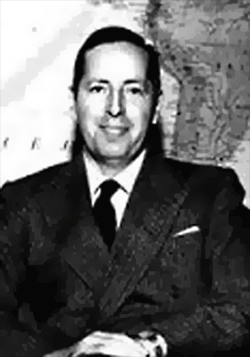 Pan Am’s Latin American Division manager, Humphrey W. Toomey
(left) seemed to lend emphasis to Jansen’s statement. Air freight,
Toomey explained, “opens new markets and wins new customers”
in domestic and international trade.
Pan Am’s Latin American Division manager, Humphrey W. Toomey
(left) seemed to lend emphasis to Jansen’s statement. Air freight,
Toomey explained, “opens new markets and wins new customers”
in domestic and international trade.
In his view, the smart businessman utilizes
air transport as an effective instrument for market expansion and
greater profitability.
In the context of the adage that time
and tide stay for no man, Kenneth N. Hynes’ analysis of postwar
U.S.-China air trade provided a perfect example of the certainty—never
linger. Hynes, who served in the Commerce Department’s Office
of International Trade, described the “character” of trade
between the two countries as “essentially an exchange of American-manufactured
products for raw materials.” He reasoned that the airline operating
out of the U.S. can expect only “a very limited volume of manufactured
goods and commodities” transported eastbound. Result: “return
haul problem that will be difficult to solve.”
In New York, Eric Rath, president of
Airload Service, Inc., told a Board of Trade audience that while airlines
have been successful in selling passenger transportation on a basis
of speed, comfort, economy and reliability—prime factors in
a shipper’s choice of transport mode—“not much hasbeen
done to apply the same standards to air freight transportation.”
Considering the position of the freight
forwarder in air transportation, John W. Moore, who headed the Port
of New York Authority’s Nonscheduled Air Transport Bureau opined,
“Until forwarders learn on what terms they may forward air freight
and with what regulations they must comply, their services which have
been so important in other fields of transportation cannot be expected
to be fully developed in the promotion of air freight business.”
The Air Freight Forwarders Association
blossomed as a national organization at a celebratory three-day meeting
(and shindig) in Washington. In a blunt speech at one of the sessions,
the forwarder was characterized as the left arm of the airline, especially
a part of the body itself.
Anatomical claims aside, the forwarder
group lost little time petitioning the Civil Aeronautics Board to
disallow a “ruinous new freight rate (12 cents per ton-mile)
filed by three scheduled airlines. The CAB promptly rejected the rate
but issued an order for investigation.
By now there was much talk of a rate
war between the scheduled airlines and the nonskeds. Pointing an accusatory
finger at American Airlines, Slick Airways charged that it had organized
a Contract Air Cargo Division for the single purpose of driving all-cargo
nonskeds out of existence.
For a welcome moment, the threat of
a looming rate war was blown away by news from abroad that the executive
committee of the International Air Transport Association had given
its stamp of approval in principle to accept international nonskeds
into IATA membership.
Ratification lay ahead.
Should cargo carriers be awarded certificates
of convenience and necessity? Facing a CAB examiner, Dr. John H. Frederick,
professor of transportation at the University of Maryland, said yes.
Against the testimony of the scheduled airlines the highly regarded
educator maintained that further examination of the cargo airlines
was unnecessary.
He argued that it was vital to avoid
the experience of the motor carrier industry after World War I when
“cut-throat competition was rampant to the detriment of public
safety, labor and investors.”
There was no need to continue experimenting,
he added, stating that “evidence now available is enough to
justify issuance of certificates of at least several years’
duration needed to give the freight carriers stability for continued
development.”
In a postwar air transport industry
still dominated by the DC-3 and DC-4, cargo tonnage numbers leaped
month after month, inevitably causing mounting handling problems at
ill-equipped airports with all manner of industry pundit predicting
a brilliant tomorrow for air freight, does its efficient handling
require a dedicated facility? If talks with airport executives across
the country are condensed to a singer answer, it is yes. But not for
a while. As a matter of fact, in some cases not for a great while.
Said Eric Rath, guiding light at Airload
Services, Inc.: “Air cargo today is just beginning to make itself
felt. Already ground facilities are inadequate. If the errors of the
railroad and motor carriers are going to be repeated, air cargo will
find itself very soon faced with conditions even worse than those
hampering surface transportation.”
Detroit’s Willow Run Airport was
the scene of the country’s first air freight terminal for the
handling of consolidated traffic over scheduled airlines. The 5,000
square foot facility was operated by Air Cargo, Inc. On the planning
board were similar facilities at airports in key cities coast to coast.
Richard Malkin
malkin101@aircargonews.com
Click
Here To Read Part I
Click
Here To Read Part II




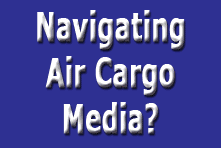

 ir
transport had to wait for decades before it could prove that the carriage
of heavy, bulky freight was a natural for the airplane. A few short
years later, America’s commercial airlines, hand in hand with
the Air Force, kept a blockaded Berlin alive with a duplicated mass
airlift of dazzling performance.
ir
transport had to wait for decades before it could prove that the carriage
of heavy, bulky freight was a natural for the airplane. A few short
years later, America’s commercial airlines, hand in hand with
the Air Force, kept a blockaded Berlin alive with a duplicated mass
airlift of dazzling performance.